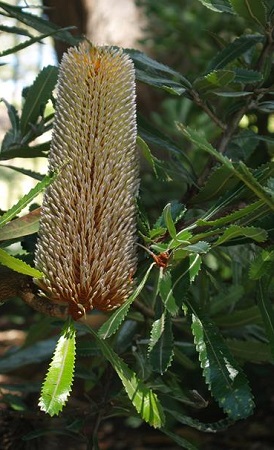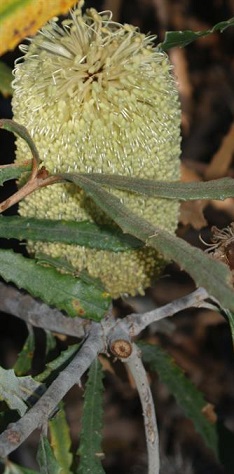Choose a Banksia to Grow that Suits Your Situation
 Banksias are easy to recognize by their distinctive, often large flower spikes. They are often referred to as ‘candles’ but actually known botanically as an inflorescence. The flowers are usually erect on the plant (but sometimes hang), and have a colour range from yellow, to orange and red and even pink. The centre of the flower head consists of a wooden axis that has a furry coating; the flowers appear in tightly packed pairs at right angles to the central wooden structure. The inflorescence is made up of hundreds to thousands of tiny flowers. Woody fruiting structures hold the black two-winged seeds after flowering.
Banksias are easy to recognize by their distinctive, often large flower spikes. They are often referred to as ‘candles’ but actually known botanically as an inflorescence. The flowers are usually erect on the plant (but sometimes hang), and have a colour range from yellow, to orange and red and even pink. The centre of the flower head consists of a wooden axis that has a furry coating; the flowers appear in tightly packed pairs at right angles to the central wooden structure. The inflorescence is made up of hundreds to thousands of tiny flowers. Woody fruiting structures hold the black two-winged seeds after flowering.
- Many species are indigenous to Western Australia (mostly the south west). Others come from the eastern states mostly along the eastern and south eastern coasts and tablelands. Banksias grow on poor, sandy soil that is often not suited to other plants.
- Flowering time: varies but it is possible to find Banksias in flower at all times of the year
- They can be small or large shrubs, groundcovers or trees.
- Hardiness: varies, but WA species are often difficult to grow in many other places
- The foliage can vary. Most have very stiff leaves with serrated margins. Young growth tips are often shades of orange, brown or red, but turning to green, blue green or a different colour as they age.
- Most Banksias are long lived; particularly trees. It is not uncommon for them to die without warning if the ground becomes too wet though.
Species Include
B. aculeata Hardy in well drained sandy soil, rare but has been grown successfully in Victoria. Comes from South East WA.
B. ashbyi Likes moist, well drained lime soil, tolerates light frosts, does best in semi arid areas and prefers to avoid humidity. From red sands, mid west coast WA, more northerly than all WA Banksias except B. dentata.
B. baueri Relatively adaptable southern WA species, doing reasonably well in south eastern Australia, but not further north than Sydney where humidity can become more of a problem.
B. baxteri Grows well in Adelaide on acidic sand over a limestone sub soil. Has lowered successfully as far north as Sydney. Indigenous to Sandy soils, southern WA .
B. brownii Difficult in cultivation, humidity a serious problem, needs excellent drainage and full or near full sun. From sandy soils, Stirling Ranges, southern WA.
B. caleyi Grows well as a grafted plant in Victoria, but results are unreliable in NSW. From Sandy flat country, often among mallee eucalypts in southern WA.
B. candolleana From sandy soils, within 50km of WA south east coast. Not commonly cultivated.
B. canei Sub alpine areas of southern NSW and Vic. Has been successfully cultivated in South of England, tolerating frost. Also grown successfully in Sydney.
B. coccinea Sandy soils, Southern WA. Difficult in cultivation, probably need perfect drainage and very low humidity
B. conferta Cultivation has been limited, but some success has been reported on the east coast Australia. From rocky slopes in limited sites in south east Qld and eastern NSW
B. cuneata Rare both in the wild and in cultivation. Sandy soils, south east WA.
B. dentata Often cultivated in the tropics, and successfully grown as far south as Melbourne. From tropical north of WA, NSW and Qld, in wet sandy soils or Savannah, also in New Guinea.
B. dryandroides Has been grown successfully in Melbourne and Sydney in a partly shaded position, with perfect drainage in a rockery. Various habitats in far south east WA.
B. ericifolia Relatively easy to grow, from the tropics to southern frost prone Areas, however still prefers good drainage. Heath and other habitats in eastern and nth eastern NSW, generally not extending any great distance from the coast.
B. gardneri Generally difficult to grow in east coast Australia, but some success has been had in parts of Vic., on very well drained sites. Sandy to rocky soils in far south WA.
B. hookeriana Doesn’t grow easily even as a grafted plant in eastern Australia. Sandy soils, eastern WA, north of Perth.
B. ilicifolia Rarely cultivated, but reportedly relatively easy to grow. Deep sandy soils alongside other Banksias, or Jarrah.
B. lavaegata Reasonably successful in cultivation grafted onto B. integrifolia, in places as diverse as Sydney, Melbourne and Toowoomba in Qld. Rocky soils, far south WA.
B. lemanniana One of the most adaptable WA species, doing well, particularly if grafted onto B. integrifolia or B. spinulosa. Sandy soils or loam, far south WA.
B. media One of the easiest WA species, grows in most reasonably drained soils, tolerates some lime, resistant to salt winds. Far south WA, variety of soils, salt tolerant.

B. menziesii Can be difficult, but has been grown successfully as a cut flower in sand in Hawaii. Grafting has been difficult. Resists salt winds. Deep sands, far south east WA, often grows with jarrah or other banksias.
B. nutans Not reliable in humid eastern states climates on its own roots, Though there are cases of successful cultivation. Seems more reliable if grafted onto B. ericifolia. Far south WA, deep sands amongst taller plants.
B. oblongifolia Very adaptable, can be grown in most soils, responds to pruning for shape. Various soils in forests of eastern Qld and sth eastern Qld.
B. occidentalis Reasonably adaptable in eastern Australia, has been grown successfully in Hawaii, excellent results if grafted onto B. integrifolia. Southern WA in organic sands, often with taller plants.
B. ornata Needs excellent drainage, full sun, and a dry soil, tolerates drought. Deep sands in arid areas of western Vic extending over the border into SA.
B. paludosa Hardy in cultivation. Sandy loams near water or in seasonally wet spots in eastern NSW.
B. petiolaris Sometimes successful in eastern states, provided drainage is excellent and excess water is avoided, particularly over summer. Heath and Mallee country, in sands, far south WA.
B. praemorsa Not reliable in humid climates, however incidents of success have been reported in both Sydney, and San Francisco in the USA. Far south east WA, on steep sand dunes.
B. pulchella Not commonly cultivated, but would need excellent drainage and Either full or part sun. On deep sands amongst shrubs and taller plants, far south WA.
B. quercifolia Not commonly cultivated but likely to be quite adaptable. Far south east WA, often on edge of swamps or occasionally in Jarrah forests.
B. repens Adaptable in areas with winter rainfall, but needs dryness and low humidity in summer. Sandy or grave soils, far southern WA.
B. robur Very hardy, growing successfully from tropical north Qld to southern Victoria, but best in sands or at least well drained soils.
B. serrata Long lived, can adapt to most soils, does best in full sun, but tolerates partial sun, avoid highly alkaline or v ery badly drained soils. Coastal and near coastal inland areas, to Great Dividing Range, usually in woodland, south east Qld NSW and Vic.
ery badly drained soils. Coastal and near coastal inland areas, to Great Dividing Range, usually in woodland, south east Qld NSW and Vic.
B. solandri Rarely cultivated, but success has been reported in Melbourne. Far south WA, sandy soils.
B. speciosa Has done well in parts of Vic, SA and NSW tablelands, but can be unreliable in humid sites on the east coast of Australia. Far south WA, deep sands, often on old dunes.
B. spinulosa Has been successful in a wide ranger of both temperate and tropical climates. Seed from tropical varieties should only be used to grow plants for cultivation in the tropics. Open forest, hill or flat land, various habitats, in patches scattered from north coastal Qld to the south coast of NSW.
B. verticillata Not reliable on the east coast of Australia, though some success has been reported in Vic and SA. Normally exposed granite outcrops, far south east WA.
B. victoriae Not commonly cultivated, though some success has been reported in SA and even Sydney. Central eastern WA.
B. violacea Not often grown in the eastern states, but there are reports of its culture being relatively easy.
More from ACS
134 pages, classification, cultivation, landscaping, species & hybrids
View eBook
Ebook - Discover Banksia species - climate and soil, care, propagation, commercial applications, types.
View eBook
Course - Challenging and comprehensive: identify hundreds of natives and their uses in design, as cut flowers, in cuisine etc; learn their unique cultural needs.
View Course